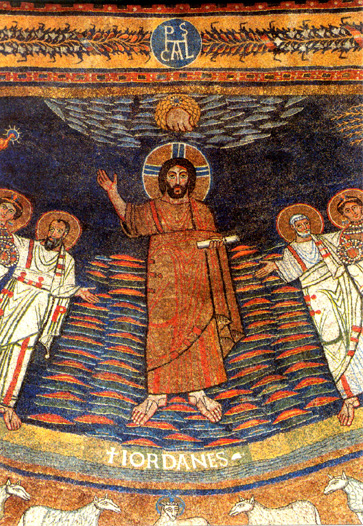







|
Symbolic Aspects
of the Monotheistic Roman Style The later-style Roman mosaic depictions of gods, which were characterized by the focus on a single god, illustrate several symbols applicable to the style as a whole. In contrast to the earlier depictions of multiple gods, there exists a strong detachment of the figure of God from the earth. Not only do the mosaics tend to be created on the ceilings of holy places, but they are also created with bright colors, the extravagant use of gold and jewelry, and heavenly context. Because these mosaics were physically distanced from the ground and placed in a sort of sky setting in which one must look toward the sky to even view the art, a strong attachment and connection to the heavens is created. Christ was portrayed as existing above the world of humans, in a totally different, finer environment. Indeed a significant aura of superiority is created with these visual tools. The figure of God is given symbols of power, including gold, jewelry, and a halo. This creates the effect of giving him power not only in the real world, but in the heavenly setting as well. It separates him from the common people to a significant degree, though the occasional connection with the common people is resolved through his somewhat drab clothing. Though not creating significant unity with the people, this image does present a comforting feeling; the impression that a god is so superior to the human race and in fact looking over humanity with sympathetic eyes gives a new dimension to the portrayal of power in the Roman society. Christ’s power seems to stem from his ability to watch over the entire human race, as evidenced by his always outward expression and outstretched hands. He is set in a heavenly setting, which naturally assumes a feeling of supremacy and power, and is surrounded by gold, indicating wealth as a symbol of power and authority. |

